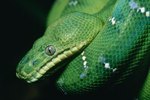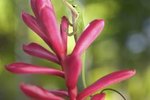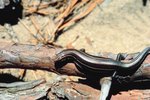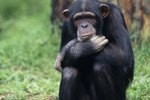
Given the high biodiversity of rain forest habitats, it is not surprising that some species living in them spend a portion of their lives hanging upside down. Some animals, such as sloths, use this peculiar posture consistently, while others, such as flying foxes, only rest upside down. In all cases, the species have evolved helpful adaptations that allow them to cling to the trees in this fashion.
Sloths
Known as one of the slowest moving animals in the world, sloths inhabit the rain forests of Central and South America. Represented by five species from two different families, sloths use their large claws to cling upside down from tree branches. Sloths are so well adapted to this upside-down lifestyle that their hair grows in such a way that it points towards the ground when they are inverted -- scientists suspect that this is an adaptation that allows the sloths to shed rainwater more easily. The sloths' claws grip branches so well that hunters don't often target the species -- even once the animals are shot, they often continue to hang from the tree, even after their death. Too slow to catch prey, sloths are herbivores that primarily consume leaves and fruit.
Snakes
Numerous snake species inhabit the trees of the rain forest, many of which spend their nights hanging from branches in hopes of capturing prey. Green tree pythons (Morelia viridis) and the behaviorally similar emerald tree boas (Corallus canninus) provide excellent examples of this behavior, though eyelash vipers (Bothriechis schlegelii), carpet pythons (Morelia spilota) and Amazon tree boas (Corallus hortulanus) exhibit the behavior as well. Hoping for a rodent or other animal to pass beneath them, these snakes use their venom or constricting ability to subdue prey once grasped. The prey is then eaten while the snake hangs from his perch. Snakes that hang in this manner usually have very strong, prehensile tails.
Bats
Using their small but strong rear legs, bats cling upside down to the bark and branches of trees throughout the rain forest. Some colonial species -- notably the flying foxes (Pteropus sp.) -- take their roosting locations very seriously; those clinging to low branches or near the edge of the group are at the greatest risk of predation. The flying foxes form social hierarchies that determine a given bat’s perching location. Strong, large males are the best fighters; accordingly, they occupy most of the best perches at the top of the tree.
Birds
While a number of bird species may temporarily cling upside down from a tree branch to tend to their nest or snatch a tasty morsel, most spend their time right side up. Exceptions to this include the beautiful blue bird of paradise (Paradisaea rudolphi), which inhabits the forests of New Guinea. Males of the species engage in elaborate courtship displays, which feature the birds hanging upside down during various parts of the performance. Additionally, nuthatches (Sitta) inhabiting the rain forest are able to creep and hop down the trunks and branches of trees while facing the ground -- a rare ability among birds.
References
- GreenPagesAustralia.com.au: Green Tree Python
- Encyclopedia of Life: Bothriechis Schlegelii
- Animal Diversity Web: Magalonychidae
- Animal Diversity Web: Bradypodidae
- MongaBay.com: Bats
- Arkive: Large Flying Fox (Pteropus Vampyrus)
- Arkive: Blue Bird-of-Paradise (Paradisaea Rudolphi)
- EcologyAsia: Nuthathes
- World Animal Foundation: Sloth Fact Sheet
Resources
Photo Credits
-
Anup Shah/Photodisc/Getty Images




